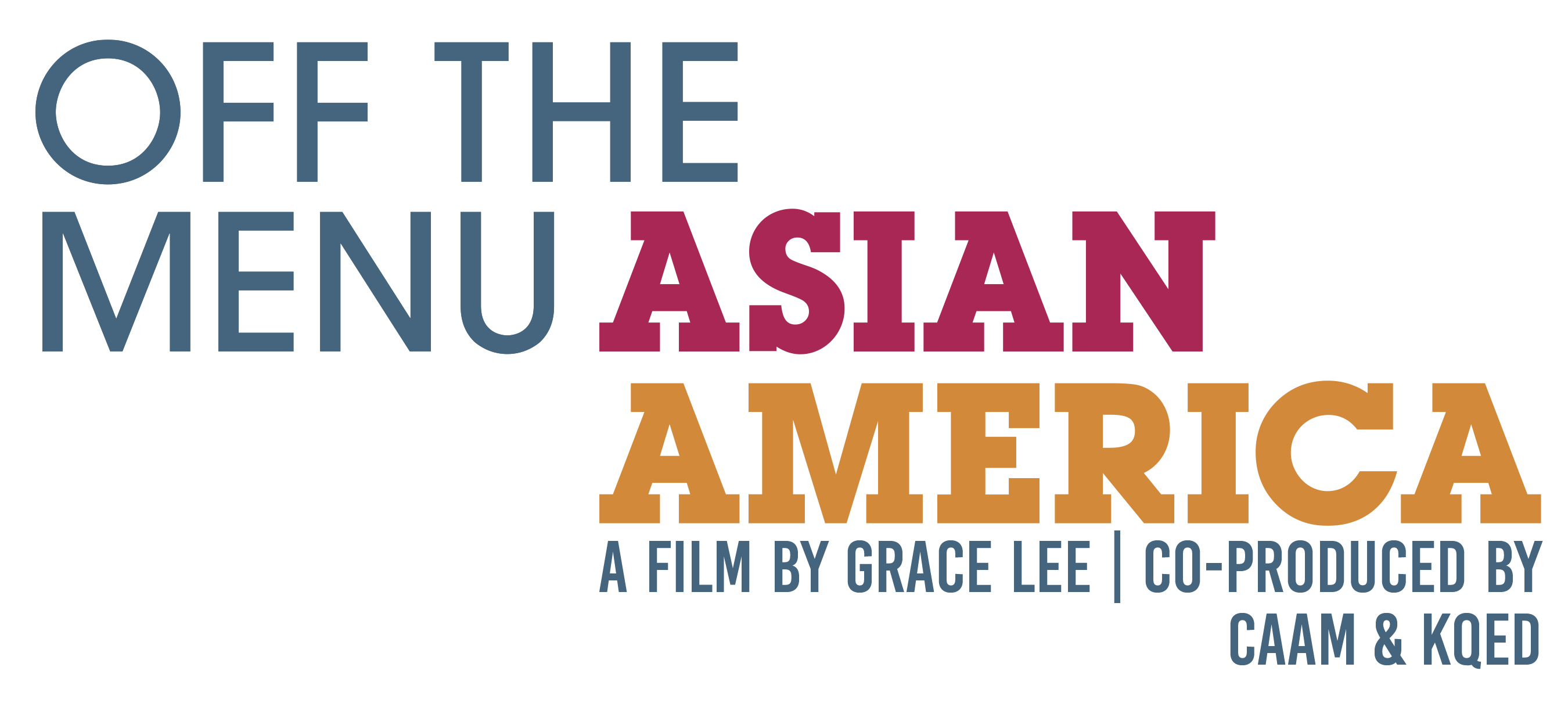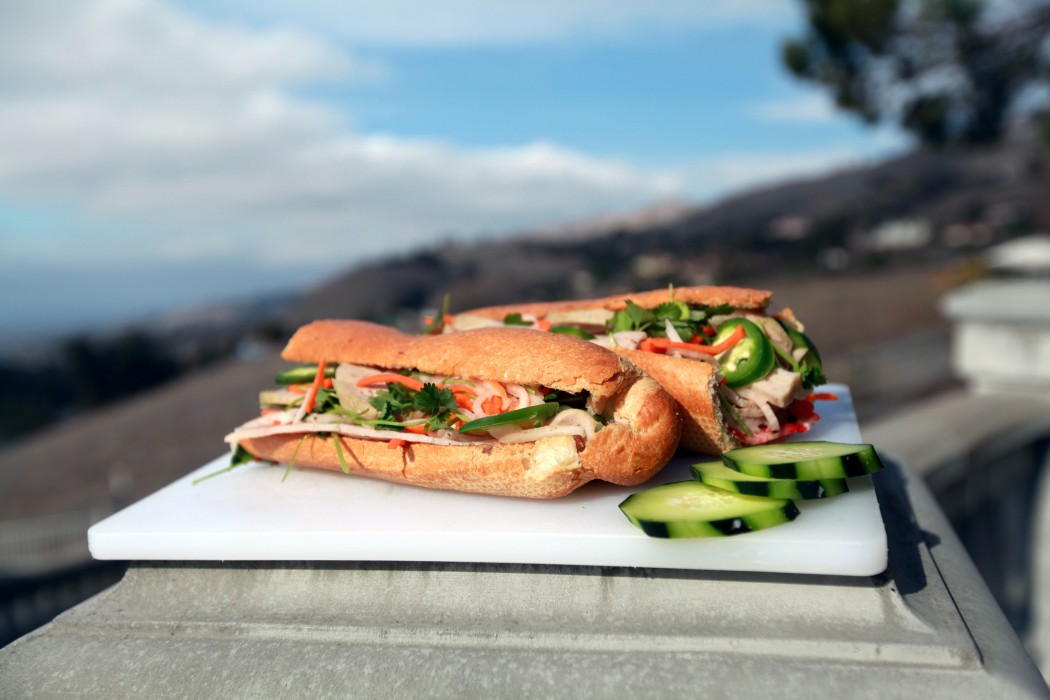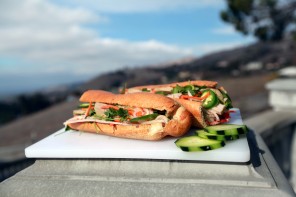When the French landed in Vietnam two centuries ago, the first culinary thing they taught the natives was the baguette—without which no Frenchman, missionary or soldier, could have endured Southeast Asia. Miraculously, on its own merit, the baguette survived the demise of colonialism, the Indochina War, World Wars I and II, the Japanese occupation, the American-Vietnam War, and even the crushing, dark decade known as the New Life Era. It endured not just in Vietnam, but also in Laos and Cambodia. It rose to staple status, priced comparably to local rice and noodles, accessible to all, including the poor.
Today, the best baguettes are found in Vietnam, followed by Cambodia, Laos, and some sections of Thailand along the Mekong River where Vietnamese refugees settled. It’s not unusual to see people eating a plain baguette alongside a bowl of pho, meat stew, curries, or even rice. The baguette’s main purpose, however, has always been to be the vehicle and the canvas for the sandwich.
Since colonial times, for the common man, bread was bought from bakeries or from door-to-door peddlers, and sandwiches were made at home. European style sandwiches could be had at French delis, though only by the French and the upper class Vietnamese. The commercial Vietnamese baguette sandwich did not come into existence until after the 1954 Geneva Accord which divided Vietnam and displaced, perhaps, millions. As refugees and immigrants (immigrants because Vietnam had just became two separate countries) fled the Communist North and streamed into Saigon, the capital of the American supported South, jobs grew scarce. Unemployed and desperate, folks opened small shops and sold food on the street. Early would-be entrepreneurs opened ill-fated noodle houses serving pho, a northern noodle soup which took nearly a decade to win over the southerners’ palate. A few turned to the baguette.
The first memorable sandwich kiosk popped up in front of Saigon Main Post Office and became an instant hit—people still remember it today. Within months, poor immigrants, with little more than a few pieces of wood, a bread basket, a few bowls of ingredients, and a clay charcoal BBQ, could set up a little food stand. Suddenly, people replicated dozens of sandwich stands all over the city. Once it spread to the provinces, people began calling the new food banh mi Saigon—the Saigon Sub, as in “fancy city food”.
The unprecedented social upheaval at the end of the Indochina War (French-Vietnam) favored Saigon Sub’s ascendancy. It was a time of great change, and people were accepting of newness, particularly when they had no choice. Hundreds of thousands went from cooking in their home kitchen to living in crowded squalor and eating inexpensive street meals. The migrated northern rich became poor with the loss of their land, home, and work. The southern poor became rich as land price in the south skyrocketed and with it the cost of housing. As the two very different cultures clashed (the north, reserved and formal; the south, gregarious and informal) so did the respective cuisines. At the beginning, displaced northerners had to eat southern food because, for the most part, they had arrived in the south with little more than what they could physically carry. Later, it was the southerners who, out of curiosity, started sampling the new dishes that the northerners cooked and sold in their communities.
Banh mi Saigon found a sweet spot as something both northerners and southerners could appreciate. It had egalitarian appeal. Educated Viet Francophile had always eaten the baguette sandwich because it was French. Laborers and students became devotees because banh mi Saigon was one of the few meals they could buy and eat on the move (note that in traditional northern culture, it was considered uncouth to walk and eat at the same time). Even the poor were drawn because unlike noodles and rice plates, these sandwiches had a sliding price scale that made them affordable to all.
Popular sandwiches were sweetened condensed milk (for young children); cha lua (Vietnamese meat cake steamed in banana leaves); fried eggs; cold cuts (ham, headcheese, and pâté), grilled meats, Chinese-style BBQ pork (usually pork belly for the prized fat), and xiu mai (pork meatballs). Because banh mi refers to bread as well as sandwich, it was necessary, when ordering, to state the type of sandwich, for instance, banh mi thit ngoui (bread with cold cuts). It was also necessary to state how much one wanted to spend for said sandwich (think of it as a name-your-price type of transaction). The price determined the amount of fillings. In general, a deluxe rich-man sandwich could cost as much as three times the basic every-man sandwich. More money translated to more fillings. In rice countries, meat was luxury, fat was decadence.
Squatting quietly at the other end of the spectrum, the “flavored” sandwiches (aka beggar’s banh mi) commonly bought by the very poor embodies, however anemically, the same flavor profile as that of the rich-man sandwich. This was simply a baguette drizzled with a few spoonfuls of pork gravy from xiu mai (Chinese meatballs), a squirt of soy-vinegar sauce, a pinch of pickled radish and carrots, chili peppers, a few sprigs of cilantro, and a light brush of butter which in tandem with the aforementioned gravy produced the rounded fatty taste, reminiscent of expensive meats.
Pricey or cheap, all Saigon subs share four defining components: (1) a crackly loaf with a soft chewy center; (2) a modest amount of fat; (3) some crunch and green herbs to convey a sense of garden freshness, and (4) a tangy sauce which may include chili peppers to bind everything.
First, the bread, usually a demi-baguette, is airy, moderately chewy, with a crunchy, crackly crust. Some mistake the Saigon Sub to be a warm creation because it is common to see a vendor lightly toasting baguettes over coals before making sandwiches. The “toasting” is meant to “awaken” the baguettes which are more fragile than their Parisian cousins. Viet baguettes differ slightly from region to region and are made with either just wheat flour or a blend of wheat and a little rice flour (in Southeast Asia, rice is cheaper than wheat), resulting in a fluffy center with a thinner crust which quickly degrades within a few hours, especially in tropical humidity. The light “toasting” is necessary to dry out the crust and revitalize the bread.
Second, butter, meat gravy, and/or pâté provide the rounded fatty taste which is key in making this protein poor sandwich so pleasing to the palate. To distinguish themselves, a handful of places even make classic French mayonnaise, hand-whipped in small batches. These fats are necessary ingredients as there is traditionally very little meat in the sandwich. In fact, Saigon subs taste better with less meat. It is common to see the lower priced shops offering julienne cha lua or BBQ meat—on the order of a single tablespoon per sandwich.
Third, daikon-carrot pickle, cilantro, and cucumber provide the perfect blend of vegetable crunch and garden freshness, conveying a brightness that belies the sandwich’s simplicity. Fussy, perishable items like lettuce and tomatoes have no place in the Saigon sub.
Last, the tangy sauce is the little magic that binds everything. Each shop likes to make its own version, with the soy-sauce and rice vinegar combination being the most common. A few uses Maggi sauce directly from the bottle. Some add a little Sriracha sauce or mashed chili peppers for a little extra zing.
It is worth noting that all ingredients can survive many hours unrefrigerated in hot weather. This, of course, came from sandwich’s humble street roots. In the modern kitchen, however, it becomes one of those fantastic backup foods that can be kept almost indefinitely. The baguette, when tightly sealed in plastic, keeps well in the freezer. Canned clarified butter and pâté keep for years in the cupboard. Fresh cilantro and chili peppers can be kept for two weeks in the refrigerator when wrapped in paper towel and stored in plastic bags. Both cilantro and chili peppers are also easily grown year round in pots.
Not only did the Saigon sub survive in Vietnam, it was carried across the world by the Vietnamese diaspora in the wake of the Vietnam War (or rather Vietnam-American War). It first surfaced in the early 80′s in two Little Saigons in California, San Jose and Garden Grove. By the mid 90′s, this little sandwich gained footholds in major metropolises in Europe, North America, and Australia. By the turn of the millennium, it was elevated to hi-so strata by a new generation of chefs, mostly US-born Vietnamese Americans (and a few who landed stateside as infants with their families), purveying superbly creative variations on this street food—only the young bloods lacked the history and had the daring to envision it in new ways for themselves. In 2011, the Saigon sub struck prime time on the Food Network with Nom Nom, a team that took second place in The Great Food Truck Race. By 2013, in the big cities, it’s safe to say the Saigon sub is definitely toeing the mainstream.
For me, the Saigon sub is linked to memories dating back to that very first kiosk in front of the Saigon Main Post Office, though by the time I munched on one as a boy, the kiosk had been in business for a decade and a half. My parents were faithful to this vendor because they had patronized his shop since their courtship days. It was one of the regular stops for our Saturday family picnics until South Vietnam collapsed.
A tumultuous decade passed before I saw the Saigon sub again. By then I was a junior in high school, living in California with my family. A Vietnamese sandwich shop named Ba Le opened in San Jose and became wildly popular among Vietnamese Americans. A friend brought me a Saigon sub for lunch one day. I remembered holding it like an old memorabilia.
Disorientation came with the first bite. A part of me leaped back over the years, across perilous journeys, hardships, and loss. I knew the flavors so well, they were like newly found tethers to forgotten memories. It was as if I was looking at the child me. There I was, five years old, pedaling my red bicycle down the long street to buy a baguette for my mother—my first big trip without training wheels. There I was sitting in primary French class with a growling stomach and staring at the clock in agony waiting for the moment when I could run out the school gate and buy the sandwich for which I had saved a week’s worth of allowance. Then, there we were sitting on the step of the cathedral, chomping on our Saigon subs, my best friend and I.
Since its re-entry into my diet, I’ve eaten more Saigon subs than any other sandwich. In college, I survived on them because they cost $1 each, with many places offering a “buy 3 get 1 free” deal. When I lived in in the jungle on the edge of the backwaters behind nowhere, I bought an oven and learned how to bake bread and make pâté just so I could eat proper Saigon subs regularly. Why was this remarkable? To bake bread in an electric oven located at the very end of an extremely long tenuous power line, I had to wait for an off-peak time and then go through my homestead and turn off the stereo, the television, and the water heater, disconnect the refrigerator, and even shut down the water pump. And even then, if my closest neighbor, a carpenter living a quarter mile up the dirt track, turned on his circular saw, my baguettes were ruined.
After reading about the NYC gourmet Viet sandwich trend, I created two gourmet subs of my own: the Big Buddha (a vegan special of fried tofu, hummus, cilantro, red bell peppers, lime juice, and cucumber) and the Chimi Cowboy (grilled steak strips, onions, butter, cucumber, and chimichuri sauce).
Though normally, when I crave a Saigon sub, I’m seeking neither novel flavor profile nor culinary enlightenment. What I long for is the memories of eating these subs on the streets of Saigon, Hoi An, Vientiane, Luang Prabang, Silhanoukville, and all those hot dusty towns in between—because life is lived for the moment as well as for the memories.
-Andrew X. Pham
MORE
Andrew X. Pham’s Classic Deluxe Saigon Sub Recipe
Andrew X. Pham is an author, critic, travel writer, rice farmer, and engineer. He lives and writes from a wooden bungalow he built on the Mekong River. He lives to eat. He exercises to eat more.
 This story is a part of Off the Menu: Asian America, a multimedia project between the Center for Asian American Media and KQED, featuring a one-hour PBS primetime special by award-winning filmmaker Grace Lee (American Revolutionary: The Evolution of Grace Lee Boggs), original stories and web content. The story was originally published at www.spoonwiz.com.
This story is a part of Off the Menu: Asian America, a multimedia project between the Center for Asian American Media and KQED, featuring a one-hour PBS primetime special by award-winning filmmaker Grace Lee (American Revolutionary: The Evolution of Grace Lee Boggs), original stories and web content. The story was originally published at www.spoonwiz.com.




